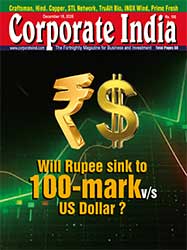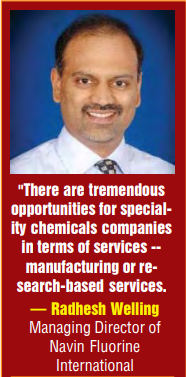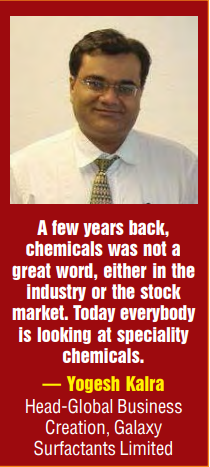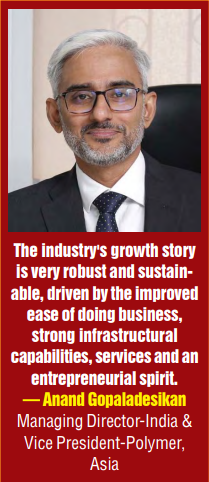Want to Subscribe?
Read Corporate India and add to your Business Intelligence

![]() Unlock Unlimited Access
Unlock Unlimited Access

Published: Nov 30, 2022
Updated: Nov 30, 2022

India has never had it so good in the rarefied field of speciality chemicals. Thanks to a combination of factors like the global slowdown caused by the Covid-19 pandemic over the last two years and the Russia-Ukraine conflict more recently, as well as production cuts in China and Europe, the country has emerged as the preferred supplier of speciality chemicals for both the domestic and overseas markets.
Thanks to the fallout of the ‘China+1’ and ‘Europe+1’ policies of global consumers, Indian importers have stopped looking at overseas supplies while the domestic industry has gone into top gear to meet local as well as overseas demand.
Notably, during fiscal 2020, when India’s overall exports shrank by 5.1 per cent on account of the pandemic, exports of speciality chemicals and fertilisers rose 3 per cent to $ 45 billion. And Indian speciality chemicals companies are reaping the dividends, with their share prices doubling and even trebling. Going by current trends, it is estimated that the Indian speciality chemicals industry will grow annually at 11-12% to reach a whopping $ 65 billion by 2025.
The Indian speciality chemicals industry has never had it so good. Notwithstanding disastrous occurences like the Covid-19 pandemic and the Russia-Ukraine conflict which have hit countries, economies and sectors across the globe very hard for around the last two years, the speciality chemicals industry is growing at a stratospheric speed. Interestingly, these calamities have in fact given a big boost to this sector! The sector is today in the limelight and is playing a pivotal role in driving the growth of the overall chemicals industry. Speciality chemicals companies are in the ninth heaven and their shareholders are quite literally minting money.
For example, Deepak Nitrite, which was available around Rs 560 two years ago, is today quoted around Rs 2,211 after touching an all-time high of Rs 2,691. The price of Navin Fluorine International has skyrocketed from Rs 1,800 to Rs 4,416 after hitting the all-time high of Rs 4,848. Alkyl Amines has shot up from Rs 948 to Rs 2,828 after touching a high of Rs 3,865, while Atul’s share price has taken an unbelievable jump from Rs 5,046 to Rs 10,859 before closing at Rs 8,893 on December 5, 2022. The price of small cap Laxmi Organics has more than doubled from Rs 202 to Rs 502 before settling at Rs 304. The quotation for another small cap, Yesho Industries, has almost trebled from around Rs 700 to Rs 2,089 before closing at Rs 1,758 on December 5. Meghmani Organics, which was friendless around Rs 44, is in demand today around Rs 115 and Thirumalai Chemicals, which had no takers around Rs 55, has today become a sought-after scrip at around Rs 210.
Experts are distinctly bullish about the domestic speciality chemicals sector. Says one, “India is emerging as a preferred manufacturing hub, including contract and custom synthesis for speciality chemicals, both for domestic as well as overseas markets.” Adds another, “The Indian speciality chemicals industry is expected to grow at 11% to 12% to reach an estimated $ 65 billion by 2025. Further, it is expected to provide an opportunity of an additional $ 60 billion across speciality chemicals segments over the next 8 to 10 years.”
No doubt, the numbers are big but what makes speciality chemicals a segment to watch out for is the role it plays in enabling India’s advances in megatrend industries such as nutrition and wellness, hygiene and personal care, water treatment, light weight vehicles (including EVs) and renewables.
There are two major driving forces behind the aromatic spurt in the fortunes of the speciality chemicals industry and the unprecedented spurt in prices of stocks of these companies. The first driving force is the decline and fall of the speciality chemicals industry in China, the major supplier of these products to the world. Ironically, this is thanks to the strict environmental protection policies of the Chinese government, which has slashed production of speciality chemicals by closing down some units and asking others to reduce output. This policy has adversely affected global customers by creating an acute shortage of their major raw material – speciality chemicals.
India has also been dependent on Chinese companies, but as supplies from China turned irregular and prices started going upwards, Indian customers of speciality chemicals started turning to domestic producers. Again, Indian importers witnessed strong tailwinds from anti-China sentiments which have spread across the globe, further discouraging them from depending on Chinese goods. This trend has given a big boost to domestic speciality chemicals companies which have started raising production capacity to meet the rising domestic demand.
At the same time, global consumers of speciality chemicals, facing difficulties in obtaining Chinese supplies, resorted to a ‘China plus one’ policy – that is, instead of depending on China alone they are turning to other suppliers in order to keep the wheels of their factories running. As India is also a reliable source and at the same time highly competitive in pricing by virtue of being a low labour cost economy, it easily fit the bill and most of the leading global importers have turned to India to meet their requirements for speciality chemicals. Realising a bumper opportunity, Indian companies started augmenting their production capacities to fit the ‘China+1’ policy bill of importing countries. The world realised that India has a strong base in agrochemicals, dyes and pigments as well as in intermediates for active pharma ingredients which constitute 27, 19 and 18 per cent respectively of the country’s speciality chemicals exports in value terms.

Little wonder, exports of Indian speciality chemicals started going up. During fiscal 2020, when India’s overall exports shrank by 5.1 per cent on account of the outbreak of the pandemic, exports of speciality chemicals and fertilisers rose 3 per cent to $ 45 billion. In fact, the country turned a net exporter of chemicals as imports stood at $ 44.3 billion – a feat achieved for the first time during the last one decade.
Another calamity that struck global economies is the intense conflict between Russia and Ukraine. As Europe extended support to Ukraine, Russia stopped supplying gas to Europe. Lower availability of gas has adversely affected the production of speciality chemicals in Europe and the rise in energy costs led to a hike in prices. This led to a turmoil in European chemicals markets and the acute shortage of gas resulted in the closure of many manufacturing facilities and a consequent spurt in chemical prices. Globally, importers of speciality chemicals who were dependent on Europe so far had no other go but to adopt a ‘Europe+1’ policy and India emerged at the forefront to fit the bill.
Consequently, several global importers of speciality chemicals from China and Europe turned to India to meet their requirements.
Themes like 'China +1', 'Europe +1' and import substitution ('Make in India') are very relevant in select pockets and the respective companies are reaping their benefits. These companies' R&D-centric and innovation-led approach has enabled select companies to compete effectively with China in terms of pricing as well as quality without having a matching scale. This approach makes these companies strong contenders as substitutes when the western world is aggressively looking to reduce its dependence on China and Europe.

Indian speciality chemicals companies have more than doubled their capex every five years and for the future too most of the companies have raised capex guidance. Some of the leading companies have 73 per cent to 152 per cent of the cumulative capex incurred during the last five-year (2016 to 2021) period. Considering capex announcements of key companies for the next three years, it can be easily said that the speciality chemicals sector is poised to deliver 25 per cent earnings CAGR over the next 5 years, maintain analysts at Nirmal Bang. They add that "a significant portion of this incremental capex is towards value-added segments."

According to Nirmal Bang, the entire sector has got massively re-rated and is trading at ~30x PE on FY24E earnings. All these names were trading at low single-digit multiples 10 years back. A sharper R&D focus, the rising salience of speciality products, strong client relationships with global giants and market opportunities on the back of themes like 'import substitution' and 'China+ 1 have led to this rerating. Also, companies with a strong focus on R&D, technology development and process innovation, and which are in a position to leverage technical know-how to widen their coverage in terms of newer applications with huge growth potential, should continue to trade at a premium to the sector's average multiple.
Maintains Radhesh Welling, Managing Director of Navin Fluorine International, a leading speciality chemicals company, "There are tremendous opportunities for speciality chemicals companies in terms of services -- manufacturing or research-based services. In order to "to convert these opportunities, it is important to have a clear point of view on where to play and how to win. Companies must do a clear assessment of what is their play: Is it the technology arbitrage or the cost arbitrage? Then you need to orient your business systems accordingly. A clear point of view should be followed by developing a set of capabilities accordingly, in technology including chemistry plus engineering, projects, operations, etc. It would help companies to identify, convert and execute the set of opportunities that we can really go after. And the third one is scale. It is very critical that we really focus on the value chains that we want to own and gradually build a business where the customers in both upstream and downstream areas come to us for services."
Adds Mr Welling, "In terms of managing the input cost specifically for raw materials, we will require both a short and mid-term tactical strategy and a longterm plan -- to build the organization and bring in the agility to identify and implement initiatives quickly. Some of the initiatives could be in the form of partnerships and how quickly we are able to identify opportunities and more importantly implement it. I am extremely encouraged by what is happening in the sector. In a decade or so I see a lot of chemical companies coming from India and becoming billion-plus dollar global organizations. The time is right for Indian chemical companies."
According to Yogesh Kalra, HeadGlobal Business Creation, Galaxy Surfactants Limited, "India is placed exceptionally well in the global arena. The stability witnessed during the Covid-19 pandemic has showcased our potential to the world. That gives me humongous confidence in terms of how the chemicals industry is moving forward. A few years back, chemicals was not a great word, either in the industry or the stock market. Today everybody is looking at speciality chemicals. One of the key drivers behind this boom is the resilience, hunger to contribute and the entrepreneurial boom."
Pointing out that "Indians are known for capitalizing on opportunities," Mr Kalra adds, "During the pandemic, we showed our best capabilities despite the limitations. The home and personal care industry has been doing exceptionally well, not only in India but outside as well. The stable environment in the country has helped advance the industry. Domestic demand across segments, including chemicals, is growing rapidly. And of course, this is coupled with the typical challenges such as the 'China plus one' issue, with global players wanting to de-risk and visit India. Before Covid-19, it was all about China but now things are moving fast. We are gearing up in terms of size, scale, innovation and creativity."
He continues, "In India, one of the best things happening is digital payments. We are ready to grow in terms innovation, scale and size. While we can't build raw materials and intermediates overnight, we have become an important destination. We will eventually become a location that is being looked at positively by suppliers. There used to be a time when Indian companies had to approach global players but now it is vice versa."

Anand Gopaladesikan Managing Director-India & Vice President-Polymer, Asia, Wacker Chemie, is very confident about the rise in demand of speciality chemicals.
He notes, "The industry's growth story is very robust and sustainable, driven by the improved ease of doing business, strong infrastructural capabilities, services and an entrepreneurial spirit. Every company is keen to invest in India but for a few challenges such as the supply factor and intermediate chemicals. At a broader level, it is an open secret. There is a need for 70 intermediate chemical plants. The supply chain, cost factor, knowledge and cost effectiveness are other key factors. We have a strong will to collaborate with Indian companies and that has to be in a way which is highly capital intensive."
In recent years, the Indian speciality chemicals basket has significantly outperformed all the leading indices. The entire sector got massively re-rated (the current valuation being 30X PE on FY24E) on the back of market opportunities across select chemistries, import substitution, 'China +1' and 'Europe +1'. Apart from the future growth potential which might be driving the stock price performance to a great extent, the financial performance of the Indian speciality chemicals companies has been far superior as compared to any other sector. Maintains Nirmal Bang, "Despite their rich valuations currently, we believe that in these speciality chemicals companies there is still enough value in select pockets from a medium-term perspective. We assign high probability to select Indian companies winning new long-term contracts in future."
Corporate India offers here a list of 15 promising Indian speciality chemicals companies.

| FACE VALUE | 05 |
| CMP | 674.15 |
| 52 WEEK HIGH /LOW | 1032/616 |
| FACE VALUE | 10 |
| CMP | 8893.45 |
| 52 WEEK HIGH /LOW | 10859/7757 |
| FACE VALUE | 02 |
| CMP | 2827.90 |
| 52 WEEK HIGH /LOW | 3865/2506 |
| FACE VALUE | 02 |
| CMP | 4416.15 |
| 52 WEEK HIGH /LOW | 4848/3361 |
| FACE VALUE | 02 |
| CMP | 2993.30 |
| 52 WEEK HIGH /LOW | 3937/2680 |
| FACE VALUE | 02 |
| CMP | 2211.15 |
| 52 WEEK HIGH /LOW | 2691/1682 |
| FACE VALUE | 10 |
| CMP | 719.95 |
| 52 WEEK HIGH /LOW | 1106/547 |
| FACE VALUE | 01 |
| CMP | 3440.75 |
| 52 WEEK HIGH /LOW | 4173/2007 |
| FACE VALUE | 02 |
| CMP | 304.00 |
| 52 WEEK HIGH /LOW | 502/274 |
| FACE VALUE | 05 |
| CMP | 6099.20 |
| 52 WEEK HIGH /LOW | 7327/3455 |
| FACE VALUE | 01 |
| CMP | 1509.35 |
| 52 WEEK HIGH /LOW | 2699/1441 |
| FACE VALUE | 10 |
| CMP | 1757.40 |
| 52 WEEK HIGH /LOW | 2099/1030 |
| FACE VALUE | 10 |
| CMP | 2252.45 |
| 52 WEEK HIGH /LOW | 2958/2032 |
| FACE VALUE | 10 |
| CMP | 2396.80 |
| 52 WEEK HIGH /LOW | 2865/2002 |

December 15, 2025 - First Issue

Industry Review

Want to Subscribe?
Read Corporate India and add to your Business Intelligence

![]() Unlock Unlimited Access
Unlock Unlimited Access
Lighter Vein

Popular Stories
Archives
